We have a nested structure of tasks in which every task can contain other tasks. Order of tasks in a task is important and is defined by the Sequence field starting at zero. Here is my table structure:
USE [MyDB]
GO
SET ANSI_NULLS ON
GO
SET QUOTED_IDENTIFIER ON
GO
CREATE TABLE [dbo].[Relation](
[PK_ID] [int] IDENTITY(1,1) NOT NULL,
[SourceEntityId] [uniqueidentifier] NOT NULL,
[TargetEntityId] [uniqueidentifier] NOT NULL,
CONSTRAINT [PK_Relation] PRIMARY KEY CLUSTERED
(
[PK_ID] ASC
)WITH (PAD_INDEX = OFF, STATISTICS_NORECOMPUTE = OFF, IGNORE_DUP_KEY = OFF, ALLOW_ROW_LOCKS = ON, ALLOW_PAGE_LOCKS = ON) ON [PRIMARY]
) ON [PRIMARY]
GO
SET ANSI_NULLS ON
GO
SET QUOTED_IDENTIFIER ON
GO
CREATE TABLE [dbo].[TaskTable1](
[Id] [uniqueidentifier] NOT NULL,
[Title] [nvarchar](max) NULL,
[SequenceId] [int] NULL
) ON [PRIMARY] TEXTIMAGE_ON [PRIMARY]
GO
SET ANSI_NULLS ON
GO
SET QUOTED_IDENTIFIER ON
GO
CREATE TABLE [dbo].[TaskTable2](
[Id] [uniqueidentifier] NOT NULL,
[Title] [nvarchar](max) NULL,
[SequenceId] [int] NULL
) ON [PRIMARY] TEXTIMAGE_ON [PRIMARY]
GO
SET IDENTITY_INSERT [dbo].[Relation] ON
GO
INSERT [dbo].[Relation] ([PK_ID], [SourceEntityId], [TargetEntityId]) VALUES (1, N'dab00c89-961c-84dd-bb43-cffd18e63594', N'5b266fd1-cbc8-c16a-91c4-5675a35c9ecf')
GO
INSERT [dbo].[Relation] ([PK_ID], [SourceEntityId], [TargetEntityId]) VALUES (2, N'dab00c89-961c-84dd-bb43-cffd18e63594', N'e499ca68-8103-b8ec-06ba-110fa3f6eb5b')
GO
INSERT [dbo].[Relation] ([PK_ID], [SourceEntityId], [TargetEntityId]) VALUES (4, N'dab00c89-961c-84dd-bb43-cffd18e63594', N'645ad2eb-df10-0d5b-0526-408aad45a145')
GO
INSERT [dbo].[Relation] ([PK_ID], [SourceEntityId], [TargetEntityId]) VALUES (5, N'785227d1-393c-ae18-02e5-03ab08d577af', N'5655aeb7-b8b5-dca9-38af-37687c668c14')
GO
INSERT [dbo].[Relation] ([PK_ID], [SourceEntityId], [TargetEntityId]) VALUES (6, N'dab00c89-961c-84dd-bb43-cffd18e63594', N'030cdefc-0e45-01e6-e2a5-a69e303bda4b')
GO
INSERT [dbo].[Relation] ([PK_ID], [SourceEntityId], [TargetEntityId]) VALUES (7, N'dab00c89-961c-84dd-bb43-cffd18e63594', N'0375c7a1-8cc5-a4c8-151c-966e4af83f73')
GO
INSERT [dbo].[Relation] ([PK_ID], [SourceEntityId], [TargetEntityId]) VALUES (8, N'dab00c89-961c-84dd-bb43-cffd18e63594', N'785227d1-393c-ae18-02e5-03ab08d577af')
GO
INSERT [dbo].[Relation] ([PK_ID], [SourceEntityId], [TargetEntityId]) VALUES (9, N'030cdefc-0e45-01e6-e2a5-a69e303bda4b', N'8324bba9-252f-bef8-c018-8b86491e2361')
GO
INSERT [dbo].[Relation] ([PK_ID], [SourceEntityId], [TargetEntityId]) VALUES (10, N'030cdefc-0e45-01e6-e2a5-a69e303bda4b', N'f1cbe8a3-3285-4cf0-096d-aad0327bdb0b')
GO
INSERT [dbo].[Relation] ([PK_ID], [SourceEntityId], [TargetEntityId]) VALUES (11, N'dab00c89-961c-84dd-bb43-cffd18e63594', N'0189f0af-5045-a498-2d70-99187bf3f0ae')
GO
INSERT [dbo].[Relation] ([PK_ID], [SourceEntityId], [TargetEntityId]) VALUES (12, N'785227d1-393c-ae18-02e5-03ab08d577af', N'ffecd091-c17b-ee5f-a64d-54ea9ff65aa9')
GO
SET IDENTITY_INSERT [dbo].[Relation] OFF
GO
INSERT [dbo].[TaskTable1] ([Id], [Title], [SequenceId]) VALUES (N'5b266fd1-cbc8-c16a-91c4-5675a35c9ecf', N'First', 0)
GO
INSERT [dbo].[TaskTable1] ([Id], [Title], [SequenceId]) VALUES (N'e499ca68-8103-b8ec-06ba-110fa3f6eb5b', N'Second', 1)
GO
INSERT [dbo].[TaskTable1] ([Id], [Title], [SequenceId]) VALUES (N'0189f0af-5045-a498-2d70-99187bf3f0ae', N'Fourth', 3)
GO
INSERT [dbo].[TaskTable1] ([Id], [Title], [SequenceId]) VALUES (N'0375c7a1-8cc5-a4c8-151c-966e4af83f73', N'Sixth', 5)
GO
INSERT [dbo].[TaskTable2] ([Id], [Title], [SequenceId]) VALUES (N'030cdefc-0e45-01e6-e2a5-a69e303bda4b', N'Fifth', 4)
GO
INSERT [dbo].[TaskTable2] ([Id], [Title], [SequenceId]) VALUES (N'785227d1-393c-ae18-02e5-03ab08d577af', N'Seventh', 6)
GO
INSERT [dbo].[TaskTable2] ([Id], [Title], [SequenceId]) VALUES (N'645ad2eb-df10-0d5b-0526-408aad45a145', N'Third', 2)
GO
INSERT [dbo].[TaskTable2] ([Id], [Title], [SequenceId]) VALUES (N'8324bba9-252f-bef8-c018-8b86491e2361', N'sub1', 0)
GO
INSERT [dbo].[TaskTable2] ([Id], [Title], [SequenceId]) VALUES (N'f1cbe8a3-3285-4cf0-096d-aad0327bdb0b', N'sub2', 1)
GO
INSERT [dbo].[TaskTable1] ([Id], [Title], [SequenceId]) VALUES (N'ffecd091-c17b-ee5f-a64d-54ea9ff65aa9', N'sub 1', 0)
GO
INSERT [dbo].[TaskTable1] ([Id], [Title], [SequenceId]) VALUES (N'5655aeb7-b8b5-dca9-38af-37687c668c14', N'sub 2', 1)
GO
To get the tasks in order with their child tasks right beneath their parents, I tried the following query to no avail:
;With TaskCTE
AS
(
select R.SourceEntityId AS ParentTask_Id, R.TargetEntityId AS Task_Id , cast(null as uniqueidentifier) AS ParentTask, 0 AS Level
, ROW_NUMBER() OVER (ORDER BY (SELECT 100)) / power(10.0,0) as x
from Relation R
where (R.SourceEntityId = 'DAB00C89-961C-84DD-BB43-CFFD18E63594')
UNION ALL
select R1.SourceEntityId , R1.TargetEntityId, TaskCTE.Task_Id , Level + 1
, x + ROW_NUMBER() OVER (ORDER BY (SELECT 100)) / power(10.0,level+1)
from Relation R1
INNER JOIN TaskCTE
ON R1.SourceEntityId = TaskCTE.Task_Id
)
select ParentTask_Id, Task_Id, ParentTask, Level
, COALESCE(TT1.Title, TT2.Title) AS Title
, COALESCE(TT1.SequenceId, TT2.SequenceId) AS SequenceId
, x
from TaskCTE
LEFT OUTER JOIN TaskTable1 TT1
ON TaskCTE.Task_Id = TT1.Id
LEFT OUTER JOIN TaskTable2 TT2
ON TaskCTE.Task_Id = TT2.Id
order by level , SequenceId
If you follow the structure of required output (shown in below image), the sequence ** column along with the **Level column must determine the sort order.
Thanks in advance


